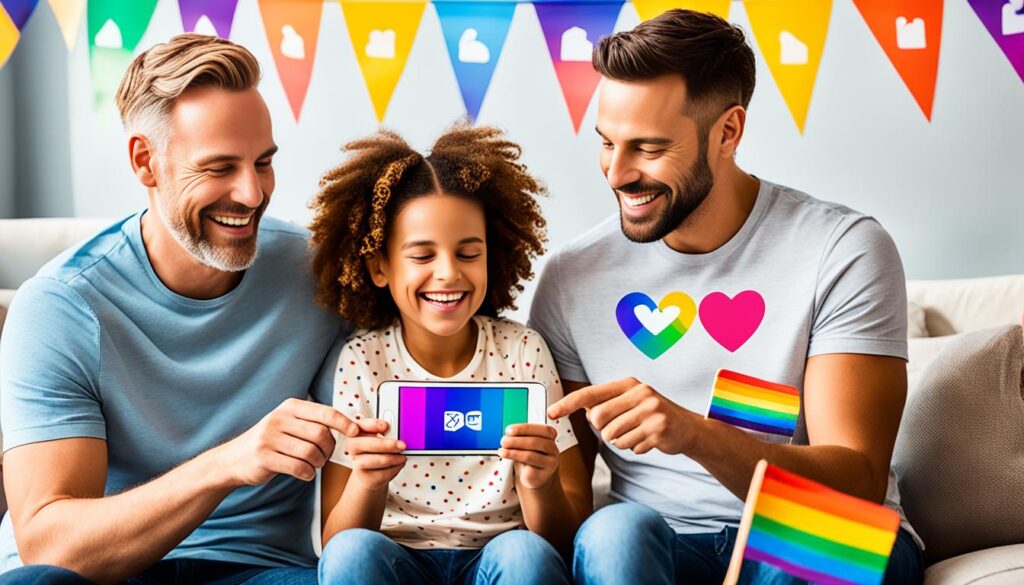{“statusCode”:401,”message”:”License key missing”}
Key Takeaways:
- LGBTQ+ youth are at a greater risk for violence and abuse, both online and offline, due to stigma and discrimination.
- NORC and Banyan Communications have developed toolkits to help parents foster healthy relationships and navigate the challenges of the teenage years.
- Acceptance from parents and adults plays a vital role in reducing mental health issues and substance use among LGBTQ+ youth.
- Creating an inclusive online environment for LGBTQ+ families is crucial for their well-being and safety.
- Navigating LGBTQ+ parenting in the digital age requires proactive efforts and open conversations.
Fostering Healthy LGBTQ+ Relationships
In a world where stigma and discrimination persist, LGBTQ+ adolescents face a higher risk of violence and abuse in their relationships compared to their straight and cisgender peers. It is crucial to address this issue and promote healthy relationships among LGBTQ+ youth to ensure their well-being and safety.
According to research, approximately one in three LGBTQ+ adolescents experience bullying at school, and one in four report online abuse. These alarming statistics demonstrate the urgent need for effective resources and support systems.
“Every child deserves to grow up in a loving and nurturing environment, free from fear and abuse. LGBTQ+ youth should not be an exception. We must take proactive steps to foster healthy relationships and protect them from dating violence,”
Recognizing the vital role of education and guidance, NORC and Banyan Communications have developed comprehensive guides specifically designed to help LGBTQ+ youth develop and maintain healthy relationships. These resources provide age-appropriate tips and tools for LGBTQ+ adolescents and their families to navigate relationship challenges, prevent dating violence, and promote well-being.
By equipping LGBTQ+ youth with knowledge about healthy relationships, consent, communication, and respect, these resources aim to empower them to build strong and meaningful connections based on mutual understanding and support.
Moreover, these guides also emphasize the importance of fostering open and supportive environments where LGBTQ+ adolescents feel comfortable discussing relationship issues and seeking help when needed.
Fostering Healthy LGBTQ+ Relationships by NORC and Banyan Communications provides:
- Tips for effective communication and conflict resolution
- Guidance on navigating social media and online relationships
- Information on consent and setting boundaries
- Signs of unhealthy relationships and strategies for addressing dating violence
Empowering LGBTQ+ youth to develop healthy relationships is a collaborative effort that involves parents, educators, and communities. By providing resources and support networks, we can create a safer and more inclusive environment that promotes the well-being and happiness of LGBTQ+ adolescents.
| Benefits of Fostering Healthy LGBTQ+ Relationships | Impact on LGBTQ+ Adolescents |
|---|---|
| Promotes emotional well-being | Reduces the risk of dating violence |
| Enhances self-esteem and self-worth | Improves mental health outcomes |
| Builds healthy communication skills | Reduces experiences of bullying |
| Fosters supportive social connections | Increases resilience in the face of discrimination |
These resources play a crucial role in empowering LGBTQ+ adolescents to navigate relationships with confidence and resilience. By fostering healthy LGBTQ+ relationships, we can create a more inclusive and safe environment for all.
Essential Tips for LGBTQ+ Parenting Teens
Parenting teenagers can be challenging, and LGBTQ+ parents may face additional complexities. As your LGBTQ+ teen navigates the transformative years of adolescence, it’s important to provide guidance, support, and understanding. To help you in this journey, NORC has partnered with Banyan for the CDC’s Division of Violence Prevention to create the resource, “Essentials for Parenting Teens.”
This comprehensive guide offers evidence-based tips and strategies for parents and caregivers of adolescents aged 11 to 17. It addresses the unique aspects of parenting LGBTQ+ teens and offers guidance on building healthy relationships, understanding and supporting their identity, and fostering their emotional well-being.
Here are some essential tips to consider:
- 1. Embrace open communication: Create a safe and non-judgmental space for your teen to express their thoughts, feelings, and concerns. Encourage them to share their experiences, questions, and emotions, and listen actively without interruption.
- 2. Educate yourself: Take the time to educate yourself about LGBTQ+ issues, terminology, and experiences. This knowledge will help you better understand your teen’s perspective and support them effectively.
- 3. Seek support: Connect with LGBTQ+ support groups, organizations, and online communities to find resources and guidance from experienced individuals who have navigated similar journeys. These communities can provide a wealth of insight and support.
- 4. Advocate for your teen: Be their ally and advocate in various settings, such as schools, medical facilities, and social environments. Ensure they have access to inclusive policies, supportive professionals, and equal opportunities.
- 5. Encourage self-care: Help your teen develop self-care practices that support their mental, emotional, and physical well-being. This can include engaging in hobbies, pursuing interests, setting boundaries, and practicing self-compassion.
- 6. Be knowledgeable about online safety: Familiarize yourself with online risks and safety measures to protect your teen in the digital age. Discuss topics like online privacy, cyberbullying, and safe social media practices.
Remember, every teenager is unique, and LGBTQ+ teens have their own specific experiences and needs. Be patient, empathetic, and accepting as you navigate this transformative period together. Your unwavering support will contribute to their well-being and self-confidence.
Finding Supportive Resources
It’s essential to have access to helpful resources that can provide guidance and support throughout your parenting journey. Check out the following organizations and websites:
- The Trevor Project – A leading organization providing crisis intervention and suicide prevention services for LGBTQ+ youth.
- GLAAD – An LGBTQ+ media advocacy organization that offers resources and education for families and allies.
- PFLAG – A national organization that offers support, education, and advocacy for LGBTQ+ individuals, their families, and allies.
Remember, you are not alone in this journey. Reach out to these organizations and others for guidance, support, and connections with like-minded individuals.
Recommended Resources for LGBTQ+ Parenting Teens
| Resource | Description |
|---|---|
| NORC’s “Essentials for Parenting Teens” | A comprehensive guide developed in partnership with Banyan for the CDC’s Division of Violence Prevention, providing tips and strategies for parenting LGBTQ+ teens. |
| The Trevor Project | An organization offering crisis intervention and suicide prevention services for LGBTQ+ youth, including a 24/7 helpline. |
| GLAAD | A media advocacy organization providing resources and education for families and allies of the LGBTQ+ community. |
| PFLAG | A national organization offering support, education, and advocacy for LGBTQ+ individuals, their families, and allies. |
Utilize these resources to enhance your understanding, gain support, and navigate the unique challenges of parenting LGBTQ+ teens with confidence and care.

The Impact of Technology on LGBTQ+ Youth
LGBTQ+ youth embrace technology as a valuable tool that empowers them in the digital age. The internet serves as a safe space where they can connect with peers, explore their identities, and express themselves authentically. Online communities play a crucial role in their lives, providing support and understanding that may be lacking in other environments.
Thorn’s research sheds light on the unique challenges faced by LGBTQ+ youth as they navigate the digital landscape. To seek community, privacy, and acceptance, they gravitate towards online spaces where identities can be freely expressed. As a result, LGBTQ+ youth spend more time in digital spheres compared to their non-LGBTQ+ peers.
“The internet has saved my life many times. It’s the only place where I can truly be myself without fear of judgment or discrimination.” – Anonymous LGBTQ+ youth
This reliance on technology, while beneficial in many ways, does expose LGBTQ+ youth to certain risks. Sharing explicit images or engaging in sensitive discussions are some examples of the challenges they face. Alongside these risks, feeling unsafe and encountering online harassment are also prevalent issues within the community.
Thorn’s research reinforces the importance of creating supportive online environments that prioritize the safety and well-being of LGBTQ+ youth. By addressing these challenges, we can foster inclusive spaces that allow for personal growth, community connection, and positive identity formation.
The following table provides an overview of the impact of technology on LGBTQ+ youth:
| Impact | Description |
|---|---|
| Identity Formation | LGBTQ+ youth utilize technology to explore and establish their identities, finding relatable communities that offer support and understanding. |
| Online communities | Online spaces provide a sense of belonging for LGBTQ+ youth, offering a platform to connect, share experiences, and find support. |
| Increased Risks | Technology exposes LGBTQ+ youth to risks such as sharing explicit images and encountering harassment, necessitating a focus on online safety measures. |
The impact of technology on LGBTQ+ youth is significant and multifaceted. While it provides a lifeline for connection and exploration, it also demands attention to the challenges and risks that come with it. By creating inclusive online spaces and promoting digital safety, we can empower LGBTQ+ youth to navigate the digital world with confidence and security.

Understanding Online Risks for LGBTQ+ Youth
LGBTQ+ youth face specific risks and challenges in the online environment. Research indicates that the sharing of intimate images, also known as sexting, has become increasingly prevalent among young people. Shockingly, approximately 1 in 5 teens admit to sharing their own nudes as a part of their digital interactions.
For LGBTQ+ teens, navigating online risks often involves handling feelings of unsafety on their own, particularly among cis non-hetero males. Due to concerns about outing their sexual orientation or gender identity, they may choose not to report experiences involving grooming, sexting, or the sharing of intimate images to their caregivers. Additionally, the fear of being cut off from their online communities can discourage LGBTQ+ youth from seeking help from their families.
It is crucial that parents of LGBTQ+ children are equipped with the knowledge and resources needed to support their children in navigating the dangers of the digital world. By understanding the unique risks faced by LGBTQ+ youth, parents can provide the necessary guidance and create an open and inclusive environment for their children to seek help and support.
Quotes:
“In the digital age, LGBTQ+ youth encounter specific challenges and risks, including the increased normalization of sharing intimate images. It is essential for parents to be aware of these risks and equipped with the knowledge to support their LGBTQ+ children effectively.” – [Expert Name], LGBTQ+ Youth Advocate
Online Risks Faced by LGBTQ+ Youth
| Risk | Description |
|---|---|
| Grooming | The process of building an emotional connection with a child or teenager to manipulate, exploit, or abuse them. |
| Sexting | The act of sending or receiving sexually explicit messages, photos, or videos through digital means. |
| Leaked Intimate Images | The unauthorized sharing of personal and intimate images, often leading to harassment, bullying, and privacy violations. |

Parents play a crucial role in protecting and supporting LGBTQ+ youth in their online experiences. By staying informed about online risks, fostering open communication, and providing resources, parents can create a safe online environment conducive to the well-being of LGBTQ+ youth.
Including Digital Safety in the Sex Talk
The traditional “sex talk” has become more complex in the digital age, especially when it comes to addressing the impact of technology on sex and dating for LGBTQ+ youth. As parents, it’s crucial to have open and honest conversations with our children about the digital safety considerations specific to their experiences.
One important topic to discuss is sexting. Explain to your child the potential risks involved in sharing intimate images through technology. Discuss the importance of consent, the permanence of digital content, and the potential consequences of sharing explicit photos. It’s crucial to emphasize that they should never feel pressured to send or receive explicit images and that they can always come to you for guidance and support.
Grooming is another topic that needs to be addressed. Talk to your child about the tactics used by online predators to manipulate and exploit vulnerable individuals. Explain that grooming can happen to anyone, regardless of their sexual orientation or gender identity, and that it’s essential to recognize the warning signs and maintain boundaries when engaging with others online.
Maintaining digital safety requires a proactive approach. Educate your child about blocking and reporting options on social media platforms and other online spaces they frequent. Familiarize yourself with safety resources specifically designed for LGBTQ+ youth and share these with your child. Additionally, make sure your child knows about anonymous helplines they can reach out to if they experience any digital safety concerns.
It’s also important to emphasize the role your child can play in helping their friends stay safe online. Encourage them to be supportive peers and provide guidance on how to recognize and address potential risks. Teach them the importance of reporting any concerning behavior they come across online to protect themselves and others.

By including digital safety in the sex talk, you equip your child with the knowledge and resources they need to navigate the digital world responsibly. Remember that ongoing communication and support are key to ensuring their well-being.
The Importance of Offline Relationships for LGBTQ+ Youth Safety
While LGBTQ+ youth often rely on online communities for support and connection, their offline relationships remain a vital source of safety and comfort. In fact, when feeling unsafe online, these youth tend to turn to their offline relationships for guidance and support. This underscores the significance of nurturing supportive offline networks and fostering open communication between LGBTQ+ youth and their caregivers.
Research has shown that having conversations about online safety with parents is highly valued by LGBTQ+ youth. When faced with unsafe online experiences, these youth prioritize reaching out to someone they know offline over someone they have met online. This emphasizes the importance of parental involvement in keeping LGBTQ+ youth safe in the digital world.
LGBTQ+ youth benefit from having trusted adults, such as parents, guardians, or mentors, with whom they can openly discuss their online experiences and concerns. By maintaining an open and non-judgmental line of communication, parents can provide guidance, support, and understanding. They can help LGBTQ+ youth navigate through the numerous challenges and risks they may encounter online, such as bullying, harassment, or discrimination.
“Parents play a crucial role in ensuring the safety and well-being of LGBTQ+ youth in the online environment. By actively engaging in conversations about online safety and fostering strong offline relationships, parents can create a supportive network for their children.”
Thorn’s research supports the notion that parental involvement is key to LGBTQ+ youth safety online. By actively participating in their child’s online world and reinforcing the importance of offline relationships, parents can help protect their children from the potential harms of unsafe online experiences. These offline relationships provide a sense of security and comfort that complements their participation in virtual communities.
Offline relationships also offer LGBTQ+ youth a safe space to express themselves freely and explore their identity without fear of judgment or discrimination. In these supportive offline settings, they can build resilience, discover their passions, and develop a strong sense of self.
It is crucial for both parents and LGBTQ+ youth to recognize the value and importance of maintaining a balance between online and offline relationships. While online communities provide a valuable support system, offline relationships offer a tangible presence and emotional security that cannot be replicated virtually.
Parents can nurture offline relationships by participating in their child’s activities, engaging in open conversations that span beyond the online world, and encouraging connections with supportive individuals and organizations in their community. By fostering these offline relationships, parents can help LGBTQ+ youth build a strong support system that complements their online experiences and contributes to their overall safety and well-being.
Supportive Offline Networks – Key to LGBTQ+ Youth Safety
A strong and supportive offline network is essential for LGBTQ+ youth safety in the digital age. By cultivating offline relationships, parents and caregivers can create a foundation of trust, love, and support that enables LGBTQ+ youth to navigate the online world more confidently. It is within these offline relationships that LGBTQ+ youth find solace, understanding, and guidance, making them an indispensable component of their overall well-being.

Key Takeaways
- Offline relationships are crucial for LGBTQ+ youth safety, providing a sense of security and emotional support.
- Research shows that LGBTQ+ youth value conversations about online safety with parents and prioritize seeking help from offline relationships.
- Parental involvement in their child’s online world is vital for ensuring LGBTQ+ youth safety.
- Offline relationships offer a safe space for LGBTQ+ youth to explore their identity and express themselves authentically.
- Parents can nurture offline relationships by participating in their child’s activities and encouraging connections within the community.
Empowering LGBTQ+ Youth to Navigate Online Risks
In today’s digital age, it is crucial to empower LGBTQ+ youth with the knowledge and resources they need to navigate online risks. Thorn, a nonprofit organization dedicated to combating online child abuse, has conducted research highlighting the importance of parental support in helping LGBTQ+ youth stay safe online.

Parents play a vital role in their children’s online safety. It is essential for parents to provide a wide range of options and resources to help their LGBTQ+ children navigate the digital world confidently. One valuable resource is Thorn for Parents, which offers practical tips, scripts, and scenario-based examples to facilitate productive conversations about online safety.
“By equipping LGBTQ+ youth with the tools they need, parents can help them navigate the digital age more confidently and ensure their safety online.”
Open communication is key to empowering LGBTQ+ youth. Parents should create a safe space for their children to discuss any online risks or concerns they may encounter. By fostering an environment of trust and understanding, parents can support their LGBTQ+ children in making informed decisions and seeking help when needed.
To illustrate the importance of parental support, here are some ways parents can empower their LGBTQ+ children:
- Encourage open dialogue: Establish regular conversations about online safety and the potential risks LGBTQ+ youth may face. Emphasize the importance of communication and reassure them that they can come to you with any concerns.
- Stay informed: Keep up-to-date with the latest online trends and platforms popular among LGBTQ+ youth. This knowledge will enable you to better understand the specific risks they may encounter.
- Provide resources: Share credible resources and tools that promote online safety for LGBTQ+ individuals. These resources may include guides, articles, and videos that address topics such as cyberbullying, grooming, and protecting personal information.
- Set boundaries: Discuss appropriate online behavior and establish clear boundaries regarding sharing personal information, interacting with strangers, and navigating social media platforms. Encourage them to trust their instincts and to seek guidance if they encounter anything suspicious or uncomfortable.
- Role model healthy online habits: Demonstrate responsible internet use and practice good digital citizenship. Lead by example as you engage with social media and online platforms, showing respect, empathy, and kindness in your online interactions.
Empowering LGBTQ+ youth to navigate online risks requires consistent parental support, open communication, and access to relevant resources. By equipping them with the tools and knowledge they need, parents can help their children safely and confidently navigate the digital landscape.
Online Safety Resources for LGBTQ+ Youth and Their Parents:
| Resource | Description |
|---|---|
| It Gets Better Project | An organization that provides support, resources, and a platform for LGBTQ+ youth to share their stories. |
| TrevorSpace | An online community for LGBTQ+ young people aged 13-24 to connect, share, and seek support. |
| GLSEN (Gay, Lesbian & Straight Education Network) | An organization that works to create safe and inclusive schools for LGBTQ+ students. |
| The Trevor Project | A leading national organization providing crisis intervention and suicide prevention services for LGBTQ+ youth. |
Promoting Inclusive and Safe Online Environments for LGBTQ+ Families
Creating an inclusive and safe online environment for LGBTQ+ families is crucial. In today’s digital age, it is important that LGBTQ+ parents and caregivers have the necessary resources and support to navigate the challenges of parenting. Schools, pediatricians, and other professionals play a vital role in promoting online safety and inclusivity for LGBTQ+ families.
One valuable resource that can be recommended to parents is the toolkit developed by NORC and Banyan Communications. This toolkit provides guidance and support specifically tailored to the needs of LGBTQ+ parents and caregivers. It offers tips on how to navigate the online world, promote digital safety, and create a positive online environment for the whole family.
By recommending these resources to parents as early as possible, professionals can empower LGBTQ+ families to tackle the unique challenges they may face in the digital world. These toolkits can help parents better understand the online landscape and equip them with strategies to ensure their children’s safety and well-being.
In addition to the toolkits, it is essential to promote inclusive practices and sensitivity towards LGBTQ+ families in online environments. This can be achieved by fostering a culture of acceptance, respect, and understanding in schools, social media platforms, and other online spaces. By creating an environment where LGBTQ+ families feel valued and supported, we can help ensure their online experiences are positive.
Furthermore, it is important to provide access to relevant resources to assist LGBTQ+ families in navigating online safety. This could include comprehensive online safety guides, educational materials, and professional support networks. By offering a range of resources, we can empower LGBTQ+ families to make informed decisions and protect themselves and their children online.
Recommendations for Promoting Inclusive and Safe Online Environments for LGBTQ+ Families:
- Advocate for LGBTQ+ inclusive policies and practices in online spaces.
- Provide LGBTQ+ families with resources and support specific to their needs.
- Encourage open communication between parents, caregivers, and children about online safety.
- Offer workshops and training sessions for professionals on LGBTQ+ issues and online safety.
- Incorporate LGBTQ+ perspectives in online safety curricula.
By taking these steps, we can create inclusive and safe online environments that support the well-being and safety of LGBTQ+ families. Together, we can make a difference in the lives of LGBTQ+ parents, caregivers, and children, ensuring that their online experiences are positive, affirming, and secure.
| Benefits of Promoting Inclusive and Safe Online Environments for LGBTQ+ Families | Actions for Promoting Inclusive and Safe Online Environments for LGBTQ+ Families |
|---|---|
| 1. Increased sense of belonging for LGBTQ+ families in online spaces | 1. Advocate for LGBTQ+ inclusive policies and practices in online spaces |
| 2. Improved mental health and well-being of LGBTQ+ parents and children | 2. Provide LGBTQ+ families with resources and support specific to their needs |
| 3. Enhanced online safety and protection against cyberbullying and discrimination | 3. Encourage open communication between parents, caregivers, and children about online safety |
| 4. Strengthened relationships between LGBTQ+ parents, caregivers, and children | 4. Offer workshops and training sessions for professionals on LGBTQ+ issues and online safety |
| 5. Improved awareness and understanding of LGBTQ+ experiences among online communities | 5. Incorporate LGBTQ+ perspectives in online safety curricula |
Remember, creating an inclusive and safe online environment for LGBTQ+ families is a shared responsibility. Let’s work together to promote online safety, acceptance, and support for all.

Conclusion
Navigating LGBTQ+ parenting in the digital age requires proactive efforts to create a safe and inclusive online environment for LGBTQ+ youth and their families. Organizations like NORC, Banyan Communications, and Thorn have developed valuable resources and conducted extensive research to address the unique challenges faced by LGBTQ+ families in the online world.
Parents, caregivers, and professionals play a crucial role in this journey. By having open and honest conversations, providing support, and equipping LGBTQ+ youth with the necessary knowledge and tools, we can help them navigate online risks and ensure their safety.
Working together, we can create a positive and empowering experience for all LGBTQ+ parents and their children in the digital age. Let’s continue to foster an inclusive online environment, where love, acceptance, and understanding thrive.









